To create a home ideal for aging in place, embrace open floor plans for better mobility and clear pathways. Enhance lighting to reduce hazards and prioritize non-slip flooring for safety. Strategically install grab bars and handrails where needed, and choose adjustable furniture for versatility. Rethink your kitchen design for accessibility, and incorporate smart home technology for convenience. With these steps, you can enhance comfort and independence. Discover more tips to enrich your space and enhance safety!
Key Takeaways
- Embrace open floor plans with clear pathways of at least 36 inches to enhance mobility and safety for seniors.
- Install motion sensor lighting and use indirect lighting to improve visibility and reduce fall hazards in the home.
- Choose non-slip flooring materials and add grab bars in critical areas like bathrooms and staircases for increased safety.
- Incorporate adjustable furniture to accommodate evolving needs and promote ease of use without strain for aging individuals.
- Utilize smart home technology for convenience, such as automatic stove shut-off and integrated security systems for enhanced safety.
Embrace Open Floor Plans for Better Mobility

When you embrace open floor plans, you create a more accessible living space that enhances mobility for everyone, especially seniors.
This Aging in Place Design minimizes obstructions, allowing for wider pathways that make moving around easier for those using mobility aids.
With fewer walls, you improve visibility across spaces, reducing the risk of falls and enhancing safety.
Open layouts foster social interaction, which helps combat isolation among older adults.
You can also easily accommodate adaptive equipment like walkers and wheelchairs, ensuring all areas of your home remain accessible.
Incorporating wider doorways (at least 36 inches) and no-step entries into an open floor plan further supports independence and accessibility, making your home a welcoming haven for aging inhabitants.
Additionally, creating spaces that allow for seasonal produce can encourage healthier eating habits, which is essential for maintaining overall well-being as one ages.
Enhance Lighting to Reduce Hazards
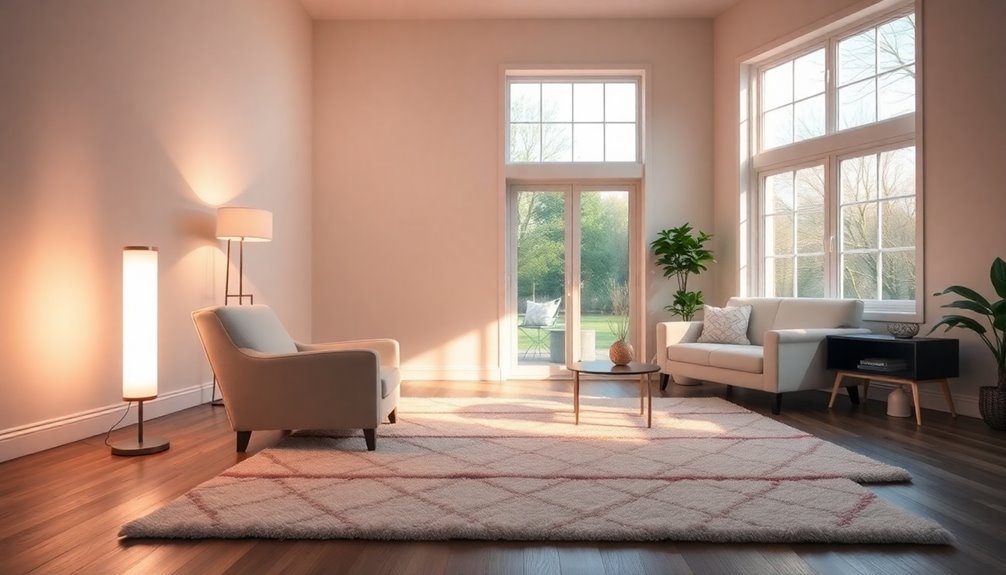
An open floor plan sets the stage for a safer home, but enhancing lighting takes safety to the next level. Increased visibility is vital as aging reduces the light reaching the retina, making brighter spaces essential for preventing trips and falls.
Consider installing motion sensor lighting in hallways and bathrooms; it illuminates areas automatically when you move, keeping your home safe and accessible. Use indirect lighting options like wall sconces and recessed fixtures to minimize glare and shadows, common trip hazards.
Opt for LED fixtures, which provide bright, long-lasting illumination and require less maintenance—perfect for aging in place. Aim for a color temperature between 2,700 and 3,000 Kelvin to create a warm atmosphere while improving visibility. Additionally, enhancing your home's security with security systems can further ensure safety for aging residents.
Prioritize Non-Slip Flooring Options

When designing your space for aging in place, prioritizing non-slip flooring options is essential for safety.
Choosing textured surface materials and strategically placing area rugs can help minimize the risk of slips.
Additionally, installing non-slip mats in key areas adds an extra layer of protection without sacrificing style.
Choose Textured Surface Materials
Choosing the right flooring is essential for creating a safe and inviting home for older adults.
Opt for textured surface materials like textured vinyl or rubber flooring, as they offer better traction and greatly reduce the risk of slips and falls. Cork flooring is another great option; it's soft underfoot and boasts natural anti-slip properties, making it ideal for aging in place.
In moisture-prone areas, such as kitchens and bathrooms, installing non-slip mats enhances safety while maintaining aesthetic appeal.
Additionally, choose flooring with a matte finish to minimize glare, improving visibility.
Confirm connections between different materials are flush and consider using contrasting colors to signal changes in level, helping to prevent tripping hazards.
Implement Area Rugs Strategically
To create a safe environment for older adults, implementing area rugs strategically is essential. When choosing area rugs, prioritize non-slip options with rubber backing to reduce the risk of falls.
Securely anchor your rugs and make sure they've no-curl edges to prevent trip hazards, especially for those with balance issues. Opt for low-profile rugs that don't exceed a quarter-inch in height to minimize tripping while moving between surfaces.
Additionally, select rugs with contrasting colors to the surrounding flooring to improve visibility and assist those with impaired vision in identifying changes in surface levels.
Finally, regularly inspect and maintain area rugs to address any worn or frayed edges that could pose significant risks. Consistent maintenance and cleaning of your home environment can further enhance safety and comfort for aging individuals.
Install Non-Slip Mats
While it's essential to create a safe home for older adults, installing non-slip mats can make a significant difference in preventing slips and falls.
Place non-slip mats strategically in high-risk areas like bathrooms, kitchens, and entryways. Consider anti-fatigue mats with no-curl edges in the kitchen to enhance comfort and safety while standing.
For bathrooms, textured vinyl flooring provides better traction than slippery tiles. Adding non-slip mats in showers and bathtubs greatly improves stability, especially when paired with grab bars for extra support.
Regularly check and replace worn or damaged mats to guarantee they remain effective.
Install Grab Bars and Handrails Strategically
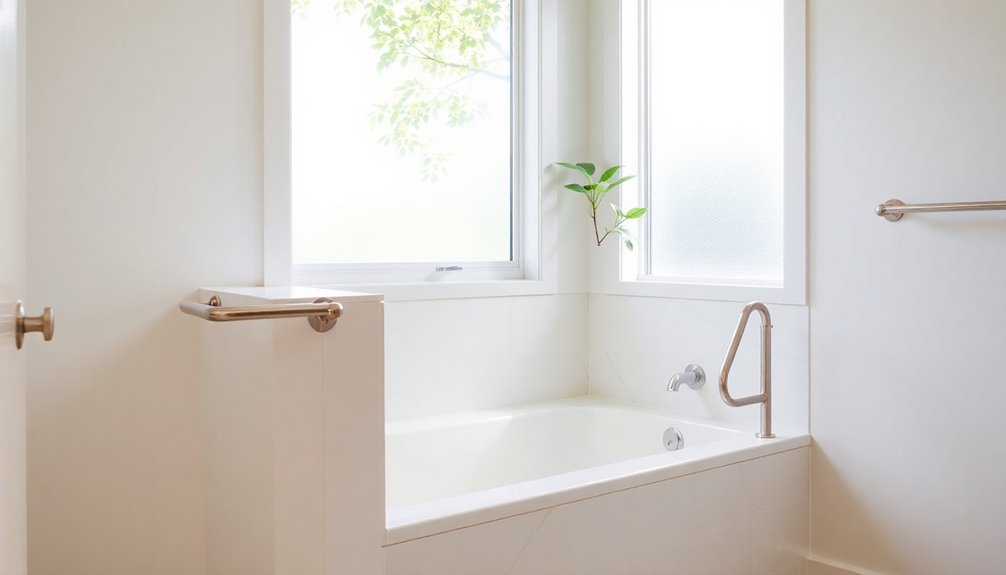
When you're planning to install grab bars and handrails, focus on high-risk areas like bathrooms and stairways.
Make sure they blend well with your decor while still offering the support you need.
Choosing the right locations and designs can enhance both safety and style in your home.
Essential Locations for Installation
Strategically installing grab bars and handrails can markedly enhance safety and independence in your home. For effective aging in place, consider these essential locations for installation:
| Location | Purpose | Key Features |
|---|---|---|
| Bathroom | Support during bathing/toileting | Install near toilet and shower |
| Stairs | Stability while ascending/descending | Handrails on both sides |
| Living Room | Assist with standing up | Place near seating areas |
| Entryway & Hallways | Aid with balance | Install near potential tripping hazards |
| Secure Anchoring | guarantee reliability | Rated for 250 pounds, anchored well |
These home upgrades will help you navigate your space safely and maintain independence. Additionally, ensure that the proper installation of grab bars and handrails complies with local safety regulations to enhance their effectiveness.
Design Aesthetics Consideration
To create a harmonious living space that prioritizes safety, it's vital to reflect on the aesthetics of grab bars and handrails.
When you strategically install these elements in high-traffic areas like the bathroom and kitchen, you enhance both safety and support for individuals with mobility challenges.
Mount grab bars at a height of 33 to 36 inches for easy access and consider using contrasting colors to improve visibility, especially for those with impaired vision.
By incorporating stylish designs, you guarantee that grab bars and handrails blend seamlessly with your home decor.
Additionally, consider pairing these features with eco-friendly practices to create a sustainable and healthy living environment.
Regularly assess their placement to adapt to the evolving needs of older adults, making design aesthetics consideration an essential part of your Interior Design strategy.
Choose Adjustable Furniture for Versatility
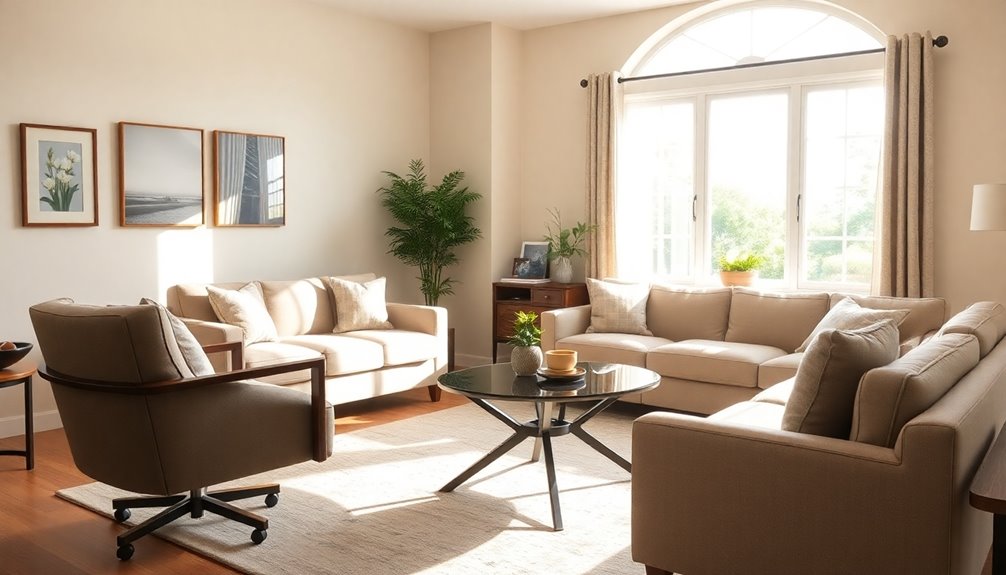
Choosing adjustable furniture can significantly enhance your home's versatility, guaranteeing it meets your evolving needs.
With options like adjustable-height desks and beds, you can create spaces that accommodate various preferences, allowing you to use them comfortably without strain.
In the kitchen, consider adjustable-height countertops and mobile islands for improved accessibility, making cooking easier for everyone.
Modular sofas offer adaptable living areas that can be reconfigured over time, keeping your space fresh and functional.
Additionally, adjustable tables and chairs can promote better posture during meals, reducing discomfort.
Finally, incorporating adjustable shelving and storage solutions guarantees you can reach items easily, minimizing fall risks and enhancing overall accessibility in your home. Furthermore, integrating features like smart bathroom technologies can provide added convenience and comfort as you age in place.
Optimize Bathroom Safety Features

To enhance bathroom safety, consider installing a curbless shower that eliminates the risk of tripping over a tub.
You should also strategically place grab bars to provide support where it's needed most, like in the shower and near the toilet.
These simple adjustments can make a big difference in maintaining independence and reducing fall risks.
Curbless Shower Installation
When planning a bathroom remodel for aging in place, consider incorporating a curbless shower, as it greatly enhances safety and accessibility.
Curbless showers eliminate barriers, reducing slip and fall risks, especially for those with mobility challenges.
Here are three key features to include:
- Non-slip flooring: Use textured vinyl or treated tiles to guarantee a secure grip.
- Proper drainage: Design the shower with a slight slope to prevent water accumulation, keeping the area safe and dry.
- Grab bars: Install grab bars within reach to provide additional support and stability during bathing.
These features not only improve safety but also promote independence, making your bathroom a more inviting space for everyone. Additionally, consider using natural materials in your decor to create a warm and welcoming atmosphere that enhances comfort.
Grab Bar Placement
Effective grab bar placement is essential for enhancing bathroom safety, especially for those aging in place. When installing grab bars, consider the following:
| Location | Height (inches) | Grip Diameter (inches) |
|---|---|---|
| Shower | 33-36 | 1.25-1.5 |
| Next to Toilet | 33-36 | 1.25-1.5 |
| Diagonal in Shower | 33-36 | 1.25-1.5 |
Make certain to anchor grab bars to wall studs for maximum strength. Opt for textured finishes to guarantee a comfortable and safe grip, especially in wet areas. Proper placement and installation of grab bars will greatly reduce the risk of falls, allowing you to move confidently in your bathroom.
Rethink Kitchen Design for Accessibility
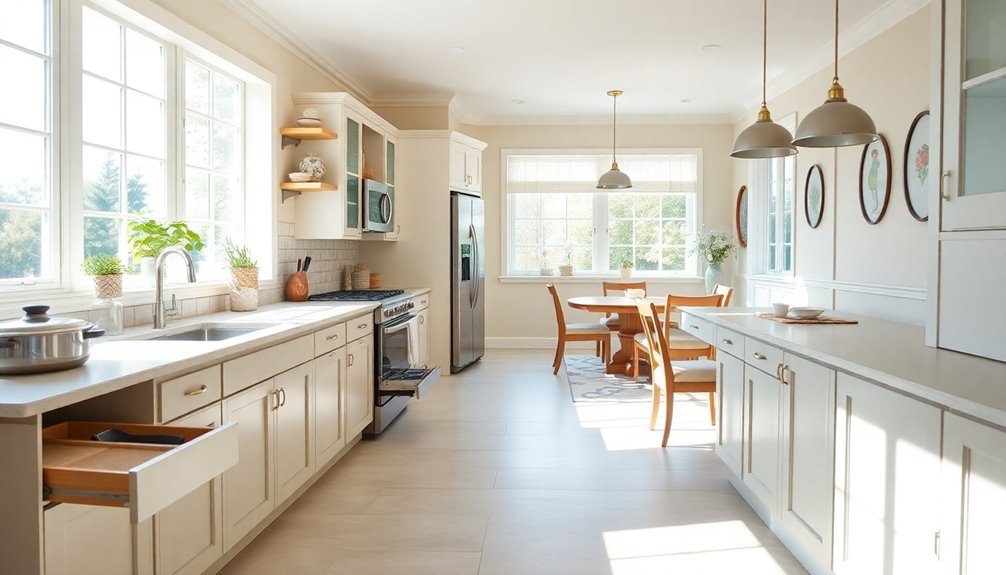
Rethinking kitchen design for accessibility can transform your cooking experience, especially as mobility needs change over time.
Here are three important adjustments to take into account for senior living:
1. Flooring: Invest in softer materials like cork or rubber to reduce joint discomfort and enhance safety.
Non-slip anti-fatigue mats can also help prevent tripping hazards.
2. Seating: Incorporate sturdy stools for sitting while cooking.
This can greatly aid mobility and reduce fatigue during meal preparations.
3. Lighting: Improve visibility by installing brighter fixtures over critical areas, such as the stove and sink.
Better lighting helps reduce the risk of accidents. Additionally, consider using an air purifier with HEPA filters to improve indoor air quality, which can further enhance the cooking environment.
These changes will make your kitchen more accessible and enjoyable as your needs evolve.
Incorporate Smart Home Technology
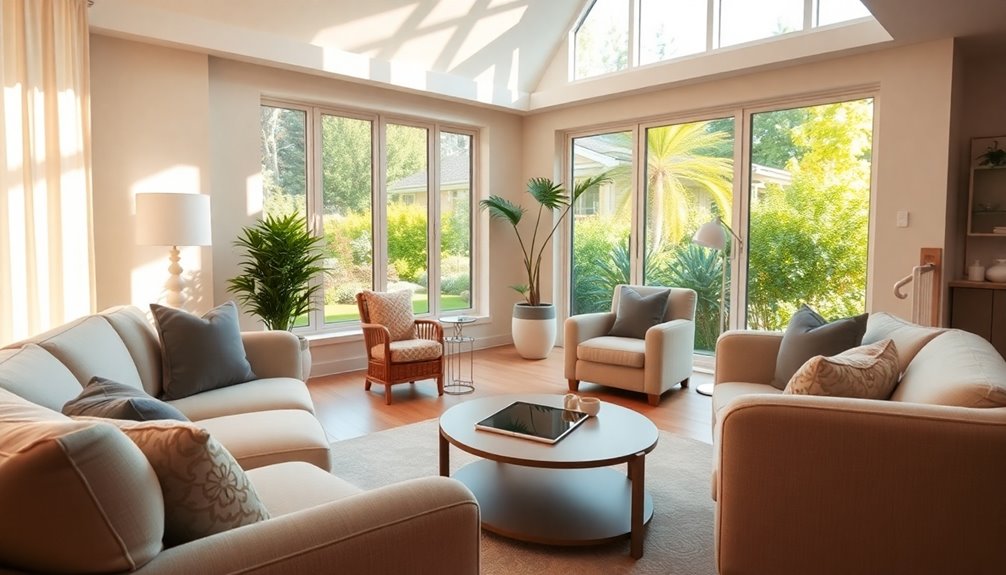
As you consider ways to enhance your home for aging in place, incorporating smart home technology can greatly improve your safety and convenience. By using devices controlled through smartphones or voice commands, you can reduce physical exertion while living independently. Automation features like scheduled lighting and temperature adjustments help create a comfortable environment. Additionally, integrating devices like robot vacuums can further assist in maintaining a clean living space without the physical strain of traditional cleaning methods.
| Smart Home Technology | Benefits |
|---|---|
| Motion Sensors | Detect inactivity and alert caregivers |
| Automatic Stove Shut-off | Reduce cooking accidents |
| Integrated Security Systems | Manage locks and cameras from one interface |
| Smart Thermostats | Adjust temperature without getting up |
Consult with an aging in place specialist to explore solutions that fit your needs. Smart solutions help you maintain safety while enjoying your independence.
Plan for Future Needs With Flexibility
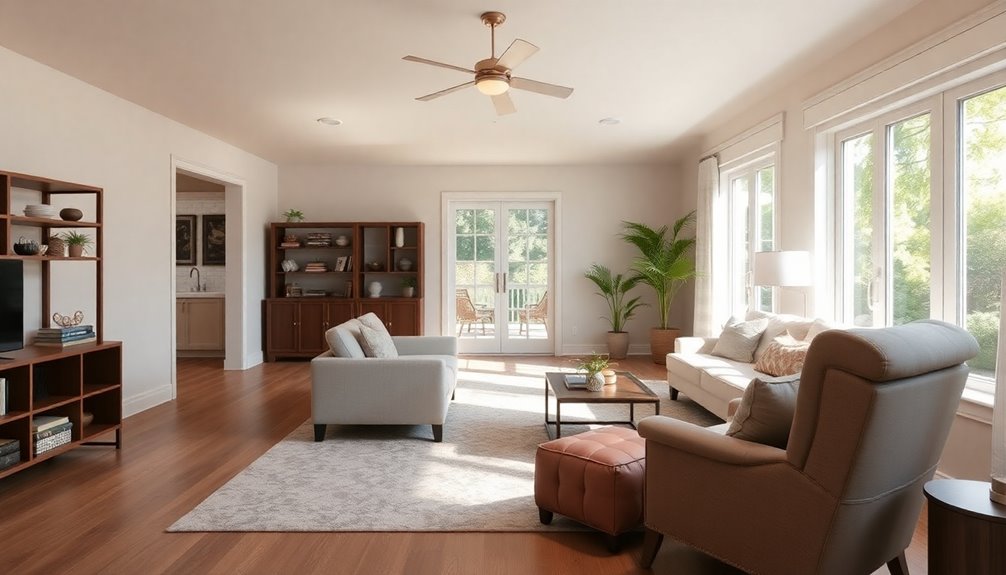
When planning your home for aging in place, it's crucial to take into account future needs and the flexibility required to adapt to changing circumstances.
Here are a few key strategies to reflect on:
- Incorporate adjustable-height furniture: Desks and kitchen counters that can be adjusted guarantee usability for everyone, regardless of mobility changes.
- Opt for an open floor plan: This design minimizes obstructions, making navigation easier as mobility challenges arise.
- Implement smart home technology: Voice-activated devices and automated lighting can adapt to future health changes, promoting independence. Additionally, consider smart technology integration that supports accessibility features enhancing everyday comfort and safety.
Create Clear Pathways and Declutter Spaces
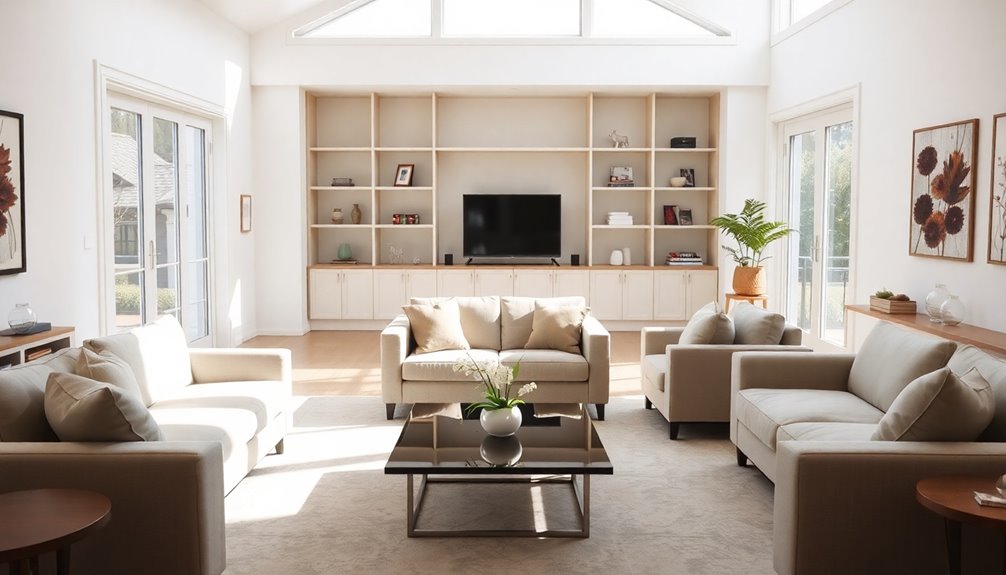
Creating clear pathways and decluttering spaces is essential for ensuring safety and accessibility in your home as you age in place. Aim for pathways that are at least 36 inches wide to accommodate walkers and wheelchairs, allowing for easy navigation.
Regularly decluttering surfaces and removing unnecessary furniture enhances your mobility, reducing fall risks. The CDC reports that 36 million older adults experience falls each year, leading to serious injuries.
Organize frequently used items within reach to avoid bending or stretching, which can strain you and increase fall risks. Implement storage solutions like bins and baskets to maintain an organized home.
This simple act of decluttering not only promotes safety but also creates a more inviting and functional living space.
Frequently Asked Questions
What Is the Best Home Design for Aging in Place?
The best home design for aging in place is one that prioritizes accessibility and safety.
You'll want a single-floor layout to avoid stairs, which can pose risks. Incorporating adjustable-height features, like sinks and countertops, keeps things flexible.
Don't forget grab bars in bathrooms and non-slip surfaces to prevent falls.
Open floor plans with wide doorways make navigation easier, while smart home technology enhances convenience, allowing you to manage your environment effortlessly.
How to Build a House to Age in Place?
Building a house to age in place is like crafting a cozy nest that adapts with you.
Start by designing a single-floor layout to avoid stairs, making mobility a breeze. Incorporate wider doorways and no-step entries for easy access.
Think about adjustable height features for added comfort. Use smart home technology for safety and convenience, and opt for an open floor plan to create a welcoming space that promotes independence and ease of movement.
What Is a Universal Design for Aging in Place?
Universal design for aging in place creates spaces that everyone can use comfortably, regardless of age or ability. It incorporates features like wider doorways and no-step entries, making navigation easier.
You'll find lever door handles and rocker light switches enhance usability, especially for those with mobility challenges. Using soft, smooth flooring reduces trip hazards, improving safety.
This approach not only supports seniors but also benefits everyone in the household, making life easier for all.
What Is Aging in Place in Interior Design?
Aging in place in interior design means creating a living space that allows you to stay comfortable and independent as you grow older.
Coincidentally, this approach emphasizes modifying your home to fit your evolving needs, like installing grab bars or improving lighting.
You'll find that these changes not only enhance safety but also maintain your familiar environment, allowing you to enjoy social connections and a sense of security as you age gracefully.
Conclusion
By implementing these interior design tricks, you can transform your home into a safe and comfortable space that supports aging in place. Remember, "an ounce of prevention is worth a pound of cure." With thoughtful planning and the right adjustments, you'll not only enhance your home's functionality but also your quality of life. So, embrace these changes now, and enjoy a peaceful, accessible environment for years to come!









